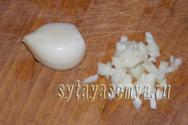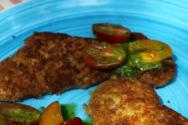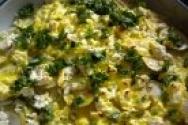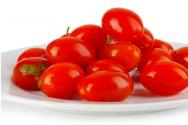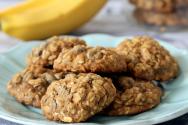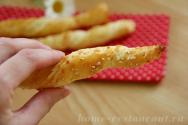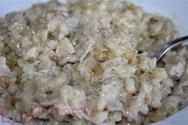How and from what to make popcorn at home? Puffed corn: is popcorn really harmful?
Often, when entering a cinema or entertainment center, we buy ourselves a whole bucket popcorn. It’s delicious, and the movie (or show) seems more interesting. This filling, low-calorie product can be prepared at home.
The best varieties
Everyone knows what popcorn is made from. From corn. But not everyone knows that Not every variety is suitable for its preparation. The grains should burst easily when fried, have good taste and the airiness inherent in popcorn.
Corn for cooking and canning is called sugar corn. It contains more starch, the shell of the grains is dense and when heated, it immediately cracks without opening. Puffed corn kernels accordingly contain less starch; The film on them is thin, but durable. Therefore, they do not burst immediately and “puff up” perfectly. 
How to make one out of this corn popcorn, Let's look at it below.
The best varieties for preparing delicacies are considered to be “Vulcan”, “Lopai-Lopai”, “Zeya”, “Ping-Pong”, “Gostinets”, “Vnuchkina Joy” and others.
The variety is a heat-loving plant, resistant to. The variety is mid-early, productive. Plant height up to 2 meters. The yellow grains have an oval, rice-like shape. The length of the cobs is about 15-22 cm. You can get up to 100-120 g of grain from one cob. This variety is also called "Volcano depraved" or "Volcano bursting."

"Gobble-gobble"
"Gobble-gobble"- mid-early, high-yielding. The plant is slightly lower in height than other varieties - 130-170 cm. The grains are yellow, wide, elongated. The cobs are cylindrical, weighing about 200-250 g.
"Zeya"
"Zeya"- early ripening variety. 80 days after planting, you can harvest. Everything is similar to other varieties, except for the grains. They are burgundy or dark red in color, wide, rounded on one side, pointed on the other.
"Ping pong"
"Ping pong"- mid-early variety. Ready for harvesting approximately 100-110 days after planting. It has short, up to 15 cm, cobs and small yellow grains.
Early variety, ready for harvest in 80 days. Its peculiarity is its high drought resistance and resistance to lodging. It tolerates high temperatures easily, so it can be grown in dry, hot regions. The plant reaches a height of more than 2 m. The cobs are about 20 cm long. The grains are yellow, pearl-shaped. 
"Granddaughter's Joy"
"Granddaughter's Joy"- a variety similar to “Zeya”, early ripening. Only it has small ears, up to 12 cm. Shoots up to 1.5 m, the grains are light orange. It has high productivity. Corn of this variety is moisture-loving, does not tolerate drought well, grows and yields only on well-fertilized soil.
U "Red popcorn" A distinctive feature is low shoots, only up to 110-120 cm. This is also an early variety. It is also distinguished by its beautiful ears, small, only 5-10 cm, similar to red grains. The taste is excellent. 
Did you know?- the main food of Mexicans and Indians.
Features of cultivation
To make popcorn at home, you first need to grow corn. Anyone can do this on their own site. Only needed optimal conditions and, of course, desire.
Corn is grown on any soil, except sandy and particularly loose soil. The plant is tall, it needs to take root firmly, but on such soils this is difficult. The crop is most often grown in the steppe and forest-steppe climatic zones, because all varieties are heat-loving. The winds in this area are strong. On weak soil, plants may “lodging”, which will negatively affect the development of the shoot and, consequently, the yield. 
Landing
One of the first conditions for successfully growing popcorn corn is planting in well-warmed soil. This means planting is in May (although everything depends on the weather).
First we prepare the soil. Let's start with an analysis of the soil and its “predecessors”.
We have already talked about soil. You can add here that the crop does not tolerate soaking, so alumina in the lowlands is also not suitable.
Everyone knows that corn cannot be planted in the same place. It will grow well after, etc. The area for planting should be such that it can accommodate 4-5 rows. The yield of a crop, if it is planted in 1 row, falls.

Before planting, you can apply for every 10 square meters a day before planting. m. about 150 g. The soil needs to be loosened to a depth of 10 cm and cultivated. There shouldn’t be any on it, otherwise the corn will take a long time to break through them. He might even die.
In addition, the grains need to be prepared for planting. First of all, they need to be soaked. To do this, they are placed in warm water with the addition of (slightly pinkish in color) and kept for a day. The grains have time to swell.
Plant directly into the ground (without growing seedlings) with mandatory watering. The best method for the crop is a square nest method of 50 cm by 50 cm. 3-4 grains are placed in a hole, watered and sprinkled with 2-3 cm of soil. Shoots will appear in 10-12 days. 
Important! Sweet corn and popcorn should not be grown near each other to prevent cross-pollination.
Care
The culture does not require special care. Frequent watering may only be necessary for moisture-loving varieties. In other cases, one watering per week at the root will be sufficient.
For high yield required 3-4 weeks after germination - organic matter. Before the emergence of “tassels” - During the formation of cobs - and
As already mentioned, weeds are the enemy of culture. You will have to weed the rows and aisles 3-4 times during the summer. The Swedish fly and corn borer can also spoil the harvest. Products purchased in a specialized store will help you deal with them. 
Corn is wind pollinated. If the weather is calm, then you can shake the stems when pollen appears on the panicles and embryos of the cobs in the leaf axils.
Collection and storage of cobs
You need to collect the cobs only when when they are well dried on the stems. Previously not recommended. If the cobs are collected raw and they do not dry out on the “root”, this will affect the opening of the grains. But we grow them precisely in order to get puffed corn.
If collected and stored correctly, the disclosure rate will be 95%.
You need to pick the cobs from the stems in the “clothing”; we will remove it immediately before storing it. After harvesting, the heads of cabbage need to be kept for another month in a cool and very dry place, then loaded into fabric or paper bags. You also need to store cobs (namely cobs, not grains) in a cool, dry place.
Important! Consumption of corn is contraindicated in case of gastric and duodenal ulcers, thrombophlebitis and increased blood clotting, low body weight and anorexia.
Making popcorn. Recipe
Next, we’ll take a closer look at how we can make popcorn at home. It turns out it's much easier than cooking regular soup or make your own pizza, which is already familiar to us. Moreover, contrary to the assurances of household appliance manufacturers, we will not need either a special machine or a microwave. You need a cast iron pot with a volume of one and a half liters, or an ordinary frying pan and a gas stove. 
Popcorn is a low-calorie and very nutritious dish, but its main advantage is that it can be cooked at home. To do this, you will need a frying container, corn and a few ingredients to taste. And in just a few minutes the dish will be ready.
Corn for popcorn
They showed the world popcorn, which hundreds of years before the discovery of the continent heated the grains on stones. After this kind of frying, delicious crispy flakes were formed. In Europe, this dish originated in Ukraine. Local residents made popcorn from homemade corn and called it rams.
However, not all types of grains are ideal for roasting. Therefore, before you make popcorn from corn, you need to choose the right crop. Culinary experts advise frying only wild varieties, since their grains have a stronger and more elastic shell. Regular kettle corn is not suitable for popcorn. These types of grains quickly burst before they have time to roast properly.
It is recommended to make popcorn from the so-called “wild” popcorn. Uncultivated corn kernels have a tough shell that can withstand high temperatures. They also contain a large amount of fiber and starch. The advantage of wild varieties is that the water inside the grain has time to optimally heat up and turn into steam before the shell bursts. When the pressure reaches its maximum, the pulp is poured out and instantly fried. It is noteworthy that making corn popcorn at home is several times cheaper than buying it ready-made in the store.
Nutritional value
It is generally accepted that popcorn is a high-calorie food, which makes it unsuitable for diet. This is actually misleading, as 100 grams of roasted grains contain only 300 calories. As for nutrients, three quarters of them are carbohydrates, the remaining share is divided between fats and proteins.
Popcorn made from regular corn contains slightly more calories than popcorn made from wild corn. This dish is up to 520 calories. Popcorn also contains iron, riboflavin and thiamine, but the main component beneficial to the body is fiber, which makes up approximately 15 percent of the total mass of the product.

Popcorn in traditional form does not contain harmful substances and is ideal for diet. It’s another matter when spices or oil are added to a dish, then you definitely can’t expect any benefits, and it can hardly be called low-calorie. Some people make popcorn for dessert by mixing it with sugar or syrup. Energy value Such a dish can reach up to 900 calories per 100 grams.
It is allowed to fry grains in butter or as it withstands heat treatment well. It is important that the cooking utensils are always covered with a lid. To heat the grains evenly, shake the pan (saucepan) slightly, if possible. And don’t forget: the more oil, the higher the calorie content and the lower the vitamin value of the dish.
Harm or benefit
There are various rumors about the effect of popcorn on the human body. For example, Madonna herself has repeatedly claimed that it was he who allowed her to get into ideal shape after giving birth. In addition, nutritionists around the world unanimously say that fried corn kernels do not have many calories, but are very nutritious. They also contain a lot of fiber, which significantly reduces the risk of stomach cancer and various heart diseases.

On the other hand, before making popcorn from corn, it is important to know the disadvantages of this dish. In itself, it is harmless, but not a single cooking option is complete without adding seasonings. For example, diacytyl flavoring is widely used, which is considered a very strong allergen and has a negative effect on the lungs. Another disadvantage is the chemicals that are used to fertilize the fields. This method of increasing productivity is especially in demand in a number of countries in Europe and America.
You should not risk eating popcorn on an empty stomach or in large portions at once. An excess of corn in the diet can worsen the condition of people prone to varicose veins. It is recommended to consume this dish no more than 2-3 times a week on a full stomach.
How is popcorn made?
You can fry grains in any heat-resistant container. Popcorn made from regular corn is typically popped in a skillet. To do this, heat it up, pour in a couple of tablespoons of vegetable oil, add a pinch of salt or sugar, and only then the grains. It is important that the lid is placed on the pan before the corn starts popping. Fry only on low heat. On average, preparing one serving takes up to 10 minutes.

Some people resort to using household appliances. How to cook with corn All you need is 2 teaspoons of oil. You should pour no more than a third of a regular glass of grains into the multicooker at a time. It is not recommended to use salt as it will corrode the coating of the bowl.
You can make popcorn even faster. It is important here that the container has high sides. This method produces the highest calorie product, since all the grains must be covered with oil, and shaking the container will not be possible. Two minutes is enough to prepare one serving.
How to make popcorn from corn in a saucepan? This is the most popular method among housewives, as it does not require additional equipment or special skills. The only downside is that it takes a lot of time to prepare. To fry, fill the bottom of the pan with a thin layer of oil. Here you can safely add salt directly to the pan. You won’t be able to fry a lot of grains at one time, but there will be fewer unopened ones.
Making popcorn
You can make a delicious airy delicacy at home without much difficulty. A tall saucepan with a lid is ideal for this. Before making popcorn from corn, you need to dry the kernels well. Avid cooks also advise keeping them in the oven for about an hour. freezer so that the pressure when opening on fire is stronger.

For 100 grams of corn use 2 tbsp. spoons of butter, preferably butter. Add seasoning or salt to taste. The grains are poured evenly onto the hot bottom of the pan, after which they are covered with a lid. Fry only on low heat. You need to shake the container slightly so that all the grains are saturated with oil. After 2-3 minutes, when the corn stops “exploding,” you can lift the lid and start frying a new portion.
Caramel popcorn
Many people prefer sweet treats to salty ones. But how do you make popcorn from corn so that it's caramelized and literally melts in your mouth? To do this you will need a small saucepan, or better yet a small cauldron. For a quarter cup of corn there are 4 tablespoons of butter, 2 tablespoons of water, 1/2 spoon of soda and a glass of sugar. It would also be a good idea to add a little lemon juice.
This popcorn is fried in the traditional way in oil with the lid closed. To make caramel, you will need another pan in which water and sugar are mixed. Cook the mixture until it becomes a homogeneous viscous mass, stirring constantly. As soon as the caramel is ready, you need to quickly add soda to it. Then foam forms from the sweet mass, which must be mixed with popcorn. The dish will cool for about 5-7 minutes.
Spicy popcorn
Its peculiarity lies in the long list of ingredients. The recipe includes corn kernels, syrup, vanilla, salt, sugar, oil and chili pepper. To begin with, it is recommended to do spicy dressing. Mix 1/2 cup sugar in a vessel, 25 grams butter, 50 ml 2 spoons of water, 1 spoon of vanilla and a pinch of pepper. This whole mass is cooked over low heat for about 20 minutes.

Only after preparing the dressing can you start popping the corn popcorn. Before serving, pour hot syrup over the opened grains.
Exotic popcorn sweets
In the East, fried corn kernels are usually eaten with raisins or sweet nuts. Such dishes turn out to be very appetizing and satisfying. Before making oriental popcorn from corn, you need to prepare the icing and other ingredients.
For 1 cup of grains you need 1/2 cup of nuts and raisins, 300 grams of chocolate and 2 tablespoons of butter. The corn is roasted at the same time as the nuts. Then the raisins are added and the popcorn is filled with melted chocolate. Served on small plates in the form of cakes.
To make popcorn from regular corn, you need to dry the grains well on a radiator and cool them in the freezer (about an hour) before cooking.
The lid of the saucepan (frying pan) should fit snugly against the edges of the container.

Popcorn cooks faster in the microwave, but it turns out fluffier on a regular stovetop.
You can season it with any spices and syrups, but all such additives will affect the calorie content of the dish.
Most of the goodies that children cannot live without are, if not downright harmful, then at best conditionally useful. A pleasant exception in their environment is popcorn, or in our opinion, popcorn, which can be fried at home without any special difficulties or equipment. It turns out completely inexpensive, quickly, and most importantly - healthy, because the starch in which it is rich, after receiving heat treatment, easy to digest.
Roasted corn is also very profitable from an economic point of view. So, to fill a 4-liter container with flavored popcorn, you only need 100 g of corn kernels and a couple of tablespoons of any vegetable oil. This is getting ready favorite treat moviegoers just a few minutes.
A little history
It turns out that the ancient inhabitants of Mexico, the Aztecs, knew how to make popcorn. Of course, they did not cook it in frying pans, which had not yet been invented.
Everything was much simpler: corn grains were covered with very hot sand. The seeds could not withstand the high temperature and “exploded” from the inside. Then the sand was sifted using a sieve and delicate white “flowers” were selected. They ate them, brought them to the gods and made supplies from them. Primitive fashionistas decorated their clothes and hair with them.
Microwave or frying pan?
It depends on how convenient it is for anyone. The main thing is the result, and it, that is, crispy puffed corn with a salty or sweet taste, turns out the same.
You can see how popcorn is made from corn at any city festival: someone will put out a popper, that is, a machine for making this delicacy. Its operating principle is high temperature and pressure. It works in the microwave too, and in a frying pan - in any closed vessel that can be heated sufficiently. The main thing is that it closes well.

Special varieties are used. Cobs suitable for popcorn are quite easy to recognize: they are much smaller in size than regular ones, and the kernels themselves are oblong in shape with a pointed top. Corn kernels are very small and much harder. This is due to the skin that envelops each of them: it is quite hard, but even it bursts, unable to withstand the pressure of water vapor.
Where do they come from in corn? From the grains themselves: in the starch-rich core there is water, which, when heated, turns into steam and seeks release. So he literally turns the corn kernels inside out, turning them into beautiful and tasty “flowers.”

The question arises: how to make popcorn from ordinary corn and is it possible? Of course, it’s real, and the delicacy it makes is even more airy. But to prepare it, you need a special unit. At home, doing this is quite problematic. Therefore, popcorn requires special corn. It can be found in a supermarket or at the market, so to speak, on hand.
Popcorn: preparation
What you can't do without:
— without a microwave (frying pan, cast iron);
— containers for mixing finished fried corn;
- corn grains;
— butter (you can use any vegetable or melted butter);
- salt ( powdered sugar).
In the microwave
Popcorn in microwave oven– it’s quick and completely easy.
- Take some corn cobs. There is no need to wash them - the sterility of the product will be ensured by high temperature.
- The grains must be pulled from the cob.
- Pour oil into the pan at the rate of 4 tablespoons per 4 liter container.
- We put the grains there.
- Close the lid and place the pan in the microwave.
- When the timer goes off, take out a container filled with delicious popcorn. All that remains is to salt it or add powdered sugar - whichever you like best.
* Cook's Tips
— The number of grains per stack in the microwave oven depends on the size of the glass saucepan ( special dishes for microwave).
— We make the calculation based on the fact that 25 g after frying takes up a volume of 1 liter.
If the microwave power is 800 watts, the popcorn will cook in just 4 minutes.
Corn fried in a frying pan
Finally, how to fry corn without a microwave oven.
- You need a frying pan with a thick bottom and high sides, or even better, a cast iron.
- Pour oil into it at the rate of 3 dessert spoons (if the container is within 1.5 liters).
- Pour the grains – a 50-gram glass – into well-heated butter and immediately cover with a lid.
- If a “cannonade” begins underneath it, that is, cracking of the grains, the process is proceeding correctly. As soon as it is finished, remove the frying pan (cast iron) from the heat.
- Carefully pour the finished roasted corn into a plate with salt or sweet powder.
* Cook's Tips
— It is best to heat the frying pan over medium-intensity heat;
— It is best to mix ready-made and slightly cooled popcorn with salt or powder in a regular food bag.
Now we know how to make popcorn from corn, so to speak, without leaving the stove or microwave. No in cooking this healthy treats nothing complicated at all. And for it to be the most delicious, it must be shared with friends!
Popcorn is the most popular delicacy in the world, without which it is impossible to imagine going to the cinema, and which both children and adults love very much.
Nowadays, there are many varieties of it - traditional sweet and salty, as well as popcorn with various flavors: fruit, cheese or chocolate.
The history of popcorn
The history of popcorn begins about 7 thousand years ago. It was then that corn cultivation began in the mountainous parts of Mexico. As time passed, at the beginning of our era, corn became the staple food in America.
The ancient Indians of those years discovered that a certain type of corn swells when heated. This happens because inside the grain there is a small amount of starch in liquid form.
After this water boils, steam is formed, breaking the shell of the grain, after which it opens and increases in volume.
The process of making popcorn determined its name. The word “corn” in English sounds like “corn”, and “pop” means “burst”. The literal translation of the word “popcorn” is “popped corn.”
Popcorn appeared in Europe approximately in the 15th century, but it began to be produced in a modern way only at the end of the 19th century, when a machine for frying corn kernels was invented in the USA.
The inventor of this device was Charles Critors. To this day, the operation of popcorn machines is based on the principles of those devices.
Composition and calorie content
As you know, popcorn is made from corn. But not all of its varieties are suitable for preparing delicacies. In order for the grains to burst properly, they need to have a stronger shell that can hold moisture inside for a certain amount of time.
During this time, the resulting steam is evenly distributed throughout the grain, and at the moment of explosion, it opens the corn pulp in a certain way.
 If you try to make popcorn from ordinary grocery corn, its shell will rupture immediately and you will simply end up with a burst corn grain.
If you try to make popcorn from ordinary grocery corn, its shell will rupture immediately and you will simply end up with a burst corn grain.
In addition to grains, some manufacturers add additional components to puffed corn: nutritional supplements, sugar, salt and fat. The use of flavorings allows you to prepare delicacies with a variety of tastes.
In its pure form, without additives or flavorings, popcorn contains about 400 kcal per 100 g of product. Sweetening or adding salt to this snack increases the calorie content to 500 kcal (sugar) and 410 kcal (salt).
That is, in one movie show you can consume almost the daily amount of kcal – about 1.3 thousand.
Despite such a significant calorie content, the delicacy contains numerous vitamins and antioxidants. Vitamins B1 and B2 are important for healthy nails and hair.
Calcium has a beneficial effect on human teeth, muscles and bones. Potassium is good for the cardiovascular system.
In addition to these substances, popcorn contains plant fiber, which helps normalize digestion. Food containing fiber moves faster through the digestive tract, preventing constipation.
Of course, being a fairly high-calorie food, popcorn can harm your figure, but if you consume this product with a minimum content of salt, sugar and fat, you can only get benefits.
Popcorn - the benefits and harms of eating it
 In fact, being ordinary corn, popcorn has many beneficial properties. Eating it helps normalize intestinal function, lowers blood sugar levels, and also has a beneficial effect on the condition of the skin.
In fact, being ordinary corn, popcorn has many beneficial properties. Eating it helps normalize intestinal function, lowers blood sugar levels, and also has a beneficial effect on the condition of the skin.
Of all the “quick” snacks, such as chips, salted nuts, chocolates, popcorn is considered the most harmless. It quickly gives a feeling of fullness and is easily removed from the body.
But there is also a negative effect of popcorn on the human body. The main harm comes from the methods of preparing this dish.
The oil used to make it, found in most movie theaters and the food industry, contains the chemical diacetyl. It has been scientifically proven that this flavoring, when heated, has a negative effect on the human respiratory tract.
If we consider the method of making popcorn at home, then microwave ovens are often used for this.
And eating food exposed to microwaves can negatively affect human health, since it contains microwave energy, which is not found in traditionally prepared foods.
Besides, flavorings and flavor enhancers, often used in the production of popcorn, are harmful to health and provoke cancer.
Use during pregnancy and diet
Question about the possibility of eating popcorn when dietary nutrition occurs quite often. Of course, high-calorie popcorn that is made with quite a lot of butter, sweet or cheesy cannot help you lose weight.
But the product prepared at home is healthy and contains a small amount of calories. In small quantities it can be used as snacks and also as a substitute for bread.
Another argument in favor of eating popcorn diet menu– high fiber content. It helps cleanse the body of toxins, waste, salts and other toxic substances.
Despite the numerous advantages of puffed corn, its use during pregnancy is undesirable.
Since a woman’s body is weakened during this period, and taking into account the peculiarities of the production and preparation of popcorn by doctors, it is not recommended to eat not only the product in packaged form, but also those made at home.
The flavor enhancer monosodium glutamate, which is ubiquitous in this dish, is also prohibited for pregnant women. And food additives jeopardize the health of the expectant mother and child.
Salt disrupts the body's water balance, and sugar affects the functioning of the pancreas.
 It has long been a known fact that beekeeping products are healthy and help solve many health problems. This is the medicine!
It has long been a known fact that beekeeping products are healthy and help solve many health problems. This is the medicine!
Are you planning a fasting day? Spend it on the water. you will learn how to do it correctly.
About application olive oil on an empty stomach to improve health and lose weight, read Just one spoon of oil every day in the morning literally works wonders!
Who is contraindicated in popcorn?
Undoubtedly, corn, which is the main product from which popcorn is made, is very healthy. But it also has contraindications for consumption.
In addition, containing vitamin K, which enhances the ability of blood to clot, popcorn is not recommended for people suffering from increased blood clotting and vascular thrombosis.
People susceptible to allergic reactions should also use this food with caution. Often, corn is grown in non-ecologically clean areas and with the use of chemicals - and this can cause allergies.
If you have diseases of the gastrointestinal tract, you should also not eat corn and popcorn made from it. The same applies to people with acute peptic ulcers and gastritis.
If you have all of the listed diseases, as well as if you intend to use corn in medicinal purposes, consultation with a qualified physician is necessary.
Delicious homemade popcorn
 Cooking popcorn at home allows you to get a tasty and useful product and also save a lot of money.
Cooking popcorn at home allows you to get a tasty and useful product and also save a lot of money.
You can prepare this dish at home in three ways: on the stove, using a microwave oven and in a special popcorn maker.
Microwave cooking is the easiest and most common method. To do this you will need a bag of popcorn (semi-finished product). It needs to be placed in the oven and heated for a few minutes until cooked through.
If you plan to make popcorn not from portioned bags, but from grains, you need to place them in a container that can withstand a temperature of 200 degrees.
Refined water should be poured into the bottom of the dish vegetable oil and cover with a lid. After 5 minutes, after the characteristic pops have died down, the treat is ready.
To cook on the stove, you will need a saucepan or frying pan with high sides, as well as glass cover. The bottom of the dish must be greased with oil and heated. Only refined vegetable oil is used.
After heating the dishes to the required temperature, the grains should be immersed there and covered with a lid. As soon as they begin to burst and “shoot”, the fire must be turned off. As soon as all the grains open and turn into popcorn, you can remove the lid.
The popcorn maker is very easy to use. It heats the corn kernels evenly and does not consume much oil. In just a few minutes, this device allows you to prepare puffed corn that does not contain harmful food additives.
The only drawback of this machine is the need to purchase it, as well as the need to purchase a non-stick additive, without which the sugar added to the corn can ruin the device.
Popcorn made from corn kernels is a snack for all occasions. When prepared correctly and consumed in moderation, this delicacy will only bring pleasure and benefit.
Puffed corn (popcorn) is loved by both adults and children. Who hasn't walked through the park, or sat in the cinema with a big bucket of popcorn?
But, unfortunately, manufacturers often add harmful additives, and nutritionists recommend preparing this delicacy exclusively from homemade corn at home.
1 General information about history
The origins of making popcorn go back to the North American Indians. They were the first to discover that some varieties of maize (wild corn) begin to burst when heated.
The Indians prepared popcorn in two ways. First: whole cobs were placed in oil boiling over a fire. Second: they separated the grains and put them in small baskets, after which they hung them over the hearth and shook them periodically. And already in 1519, the navigator Hernan Cortes discovered this dish to Europeans.
1.1 Which corn is suitable for popcorn?
Not every variety is suitable for preparing this delicacy. Corn seeds, suitable for making popcorn, have a drop of water containing starch inside. Under the influence of high temperature (in the microwave or in a frying pan), the water heats up and turns into steam, which becomes cramped inside the grain. The pressure on the walls of the grain becomes unbearable and the steam bursts it from the inside.
Fun fact: Popcorn grains contain 21% more fat and protein than regular cereal grains. The composition of this cereal is similar to wheat.
Corn suitable for popcorn has thinner walls. They look shiny and varnished. The percentage of starch in them is much lower than in regular ones.
1.2 The best varieties for popcorn
Among the wide variety of types of corn, there are several of the most proven and popular:

corn for popcorn "Vulcan"
"- "Volcano". It grows up to 200 cm, the length of the cob is about 20 cm. The grains are light, oblong. One of the most disease-resistant varieties.
- "Gobble-gobble". Mid-early variety. Relatively low stem, about one and a half meters. The grains are orange and wide.
- "Zeya." One of the most spectacular varieties of corn. It has grains of a rich burgundy color. Early variety. The stem is up to 180 cm. The length of the cob is about 20-25 cm.
- "Ping pong". A tall plant, grows up to 220 cm. It produces a large number of small (120-150 mm) cobs with oblong-shaped grains.
- "Hostel". Drought-resistant variety that tolerates heat well. Tall stems reach 230 cm. Heads of cabbage are large, up to 25 cm.
- "Granddaughter's Joy". A very productive, early ripening variety, which, however, requires frequent watering. Resistant to diseases. It grows low (150 cm) and has small heads of cabbage (12-15 cm).
- "Red". A very beautiful variety with ears of deep red color. Grows up to 150 cm with small heads of cabbage. Very popular and decorative.
When choosing a variety of popping corn, take into account your location, climate, and growing conditions! Give the plant maximum the right conditions for growth, and it will definitely please you with a harvest.
1.3 Growing corn for popcorn
Growing this cereal is no different from growing regular corn. It should be remembered that the rhizome develops extremely slowly, does not like sandy soils, and the plant itself is oppressed by grass.
2 Popcorn making technology
Popcorn is most often sold as a semi-finished product with various flavors and sweeteners. The manufacturer carefully packages it in bags and you just need to put it in the microwave or oven.
But, having home-grown popping corn at home, you can not depend on the tastes of the manufacturer, but experiment yourself!

